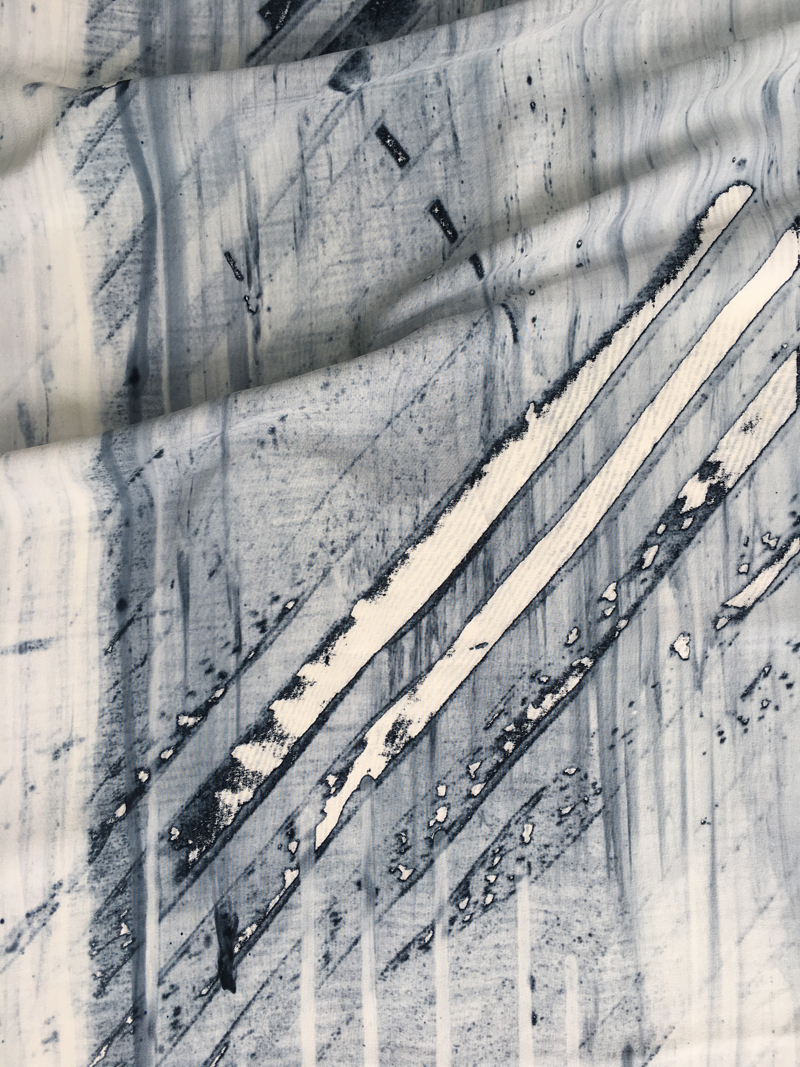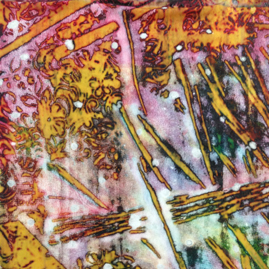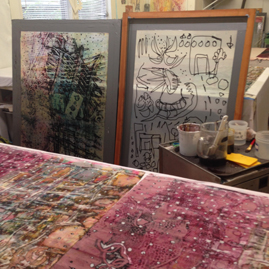Just what is Deconstructed Screen Printing (DSP) People ask me this and I have no concise answer. Here is the history of DSP and how it morphed into something that allows for infinite variations in expression. We begin in 1985, when the Loom Room in New Orleans gave me Joy Stocksdale's book Polychromatic Screen Printing. It is a wonderful, well-written and well-researched book--- it didn't speak to me at the time but without Joy's book, Deconstructed Screen Printing probably would not exist. Five years later I had a studio at Peters Valley Craft Center in NJ with print tables on one floor (in the dining room) and wash out facilities in the basement. To say that I dreaded hauling my BIG, DRIPPING, MESSY screens down the tiny farmhouse stairs to the basement is a huge understatement----soooo I did what any slightly lazy creative person would do---I left most of the screens drying in the print room until I needed them--then would haul them downstairs to wash. In one of those "light-bulb" and seemingly obvious moments I remembered Joy's book and that she released dry dye from the screen with sodium alginate thickener. So I did. It was a screen that had masking tape as a stencil. I removed all of the tape that I could get off and I printed. The texture was a thing of beauty and a revelation to me. Texture was the one thing I most wanted in my prints. I kept printing and playing with ideas, at that time primarily using wrinkled paper and other textures under the screen, along with paper stencils, which I removed prior to printing. The more I played, the more possibilities were revealed. What a cool way to work! Itís time to share!! I decided to send a proposal to teach at the 1997 SDA (Surface Design Association) Conference in Lawrence, Kansas. The proposal, of course, was due the next day. The only solution was to visit friends Linda France and David Hartge Through the night and over much wine, they helped me create a name for the technique and write the proposal. We very intellectually decided to call it Deconstructed Screen Printing, since what I was doing was deconstructing the traditional idea of screen printing (that of identical multiples achieved by some type of stencil) Since that night, thanks to my and my studentsí enthusiastic experimentation and play, DSP has grown and morphed into a form of expression that everyone can make their own. It has also shown what a community can achieve when ideas are shared. I would have never thought of the idea without Joy's book; since then I published Deconstructed Screen Printing DVD, Leslie Morgan and Claire Benn presented their own version in the book Breakdown Printing after learning DSP from Laura Beehler, one of my students. Rayna Gilman has an excellent section on DSP in her book Create Your Own Hand-printed Cloth. This type of sharing is what keeps ideas alive and growing. So, again, WHAT IS DSP? DSP essentially utilizes dry, thickened (or not) dye as a slowly disintegrating resist on a screen. The dye can be applied numerous ways and most types of dye that can be thickened (with various thickeners) can be used. In the most basic application, a texture (or textures) is (are) placed under the screen. Thickened dye is pulled over, leaving the imprint of the texture in the screen mesh. This imprinted texture is dried in the screen and then released with sodium alginate thickener. The areas with thin dye deposits release and print first, while the thicker dye deposits act as a resist and release more slowly, creating a rich, textural surface. (I could use this as a metaphor for ageing and the richness of life but will leave that for your interpretation.) The simplicity of the technique allows for marks unique to each individual. REMEMBER, the above definition is just the beginning, the basic idea as you begin working. The process will lead you astray into infinite possibilities of self-expression. |

detail of print from 2016

